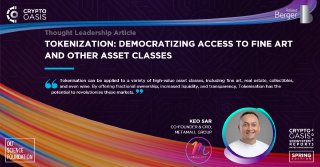Increasing Financial Inclusion through Asset Accessibility
Introduction
I had the recent privilege of speaking at a Blockchain conference, Block on the Beach (BOB), in Phuket, Thailand. The topic of our panel was, Tokenization and Digital Assets–Relevance in Today’s World. With AI’s current moment in the sun, Blockchain and its related technologies seemed to have receded into the shadows. The topic was certainly timely, and the discussion lively. While all the panelists approached the topic from different perspectives, we were all in agreement that Tokenization and digital assets are absolutely still relevant and still have a future. One of the specific use cases is as a vehicle to access high-value assets that were not previously accessible to the average person or investor.
Fine art and other high-value asset classes have long been exclusive and difficult to access for the average investor. However, the advent of Tokenization is changing the status quo, providing a new, more inclusive way for individuals to participate in the ownership of these assets. Tokenization leverages Blockchain technology to break down high-value assets into smaller, more affordable shares, allowing more people to invest in and benefit from the appreciation of these assets. In this article, we will explore how Tokenization works and its potential to democratise access to fine art and other asset classes, thus increasing financial inclusion.
Tokenization: A Primer
To set a baseline, Tokenization is the process of converting the ownership rights of a physical or digital asset into digital tokens. Each token represents a fractional share of the asset, which can be bought, sold, or traded on digital platforms. By breaking down these assets into smaller units, Tokenization enables a broader range of investors to participate in the market, thereby increasing liquidity and democratising access.
How Tokenization Works in the Fine Art Market
My personal belief is that art is meant to be shared with the world, but scarcity breeds luxury and exclusivity, and that comes at a cost. One of the asset classes that was discussed during my recent panel was the fine art market; as it’s a prime example of an industry that can benefit from Tokenization. Traditionally, investing in fine art has been reserved almost exclusively for the wealthy and privileged, as high entry costs and lack of liquidity have acted as barriers to entry for the average investor. Tokenization has the potential to change the dynamic in several ways:
Fractional Ownership: By tokenizing a piece of art, the ownership is divided into smaller fractions, which can be sold to multiple investors. This would give people the ability to invest in fine art without having to pay the full purchase price of a piece.
Increased Liquidity: Tokenization enables investors to buy and sell their fractional shares on digital platforms, providing a secondary market for fine art investments. This increased liquidity makes it easier for investors to enter and exit the market as needed.
Transparency and Provenance: The use of Blockchain technology ensures that the ownership history and provenance of the artwork are securely recorded and easily accessible. This reduces the risk of fraud and counterfeit artwork, while also simplifying the authentication process for buyers and sellers.
Tokenization of Other Asset Classes
Tokenization can be applied to a variety of other high-value asset classes, including real estate, collectibles, and even wine. By offering fractional ownership, increased liquidity, and transparency, Tokenization has the potential to revolutionise these markets as well:
Real Estate: Tokenizing real estate allows investors to purchase fractional shares of properties, lowering the barrier to entry and providing a more affordable way for individuals to invest in this asset class. This potentially leads to a more inclusive real estate market, allowing more people to participate in property ownership and the benefits that come with it.
Collectibles: The market for collectibles, such as rare coins, cars, and sports memorabilia, can also benefit from Tokenization. By dividing these assets into smaller, tradable units, Tokenization can make it easier for collectors and investors to buy and sell these items, while also ensuring the authenticity and provenance of the collectibles.
Real-World Applications
Several platforms have emerged to cater to the Tokenization of fine art and other asset classes; here are some of my favorite:
Angelo: A platform that tokenizes physical real world art, Angelo is building an Ecosystem and community to bring high value art investing to the people. It allows investors to trade, buy, and sell real physical art fractions on their exchange. Angelo’s mission is to create the best marketplace in the world for artists, investors, & art collectors to share space in, all powered by the Web3 community.
HoneyBricks: A platform that tokenizes real estate, allowing investors to buy and trade fractional ownership in properties through syndication. HoneyBricks simplifies the investment process, removes barriers to entry, and offers greater liquidity for investors interested in diversifying their portfolios with real estate assets. Their mission is to unlock the potential of real estate.
RallyRd: A platform that tokenizes rare collectibles, such as vintage cars, watches, and sports memorabilia. RallyRd offers a way for investors to gain exposure to these unique assets without the need to maintain, store, or insure them.
Fulfilling the Tokenization Promise
While adoption is still in the early stages (but growing), Tokenization is a powerful tool that has the potential to democratise access to fine art and other high-value asset classes to create a more inclusive investment landscape. As Blockchain technology continues to evolve and mature, it can fulfill the promise of a more equitable and accessible world of investment opportunities. The best way to be part of the evolution is to get educated about Tokenization and test a platform that caters to your interest.

